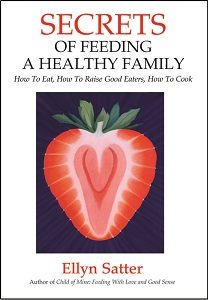

Family Meals Focus
The Ellyn Satter Institute Newsletter
The Fruit and Vegetable Agenda: Do We Really Need Numbers?
by Ellyn Satter, MS, MSSW, Dietitian and Family Therapist
For a PDF of this newsletter click here
No child ever ate according to a formula. Trying to get children to eat even modest amounts or types of food spoils eating for them, spoils the feeding relationship, and makes children’s eating worse, not better. Applying the Satter Division of Responsibility in Feeding (sDOR) and being considerate without catering in including fruits and vegetables and other basic foods groups with meals means parents don’t have to worry about formulas for their child’s food intake. But in order not to worry, parents need to be freed up from the numbers.
Parents freak out about fruit and vegetables
Why are parents so freaked out about fruits and vegetables that they pressure, entice, and force and even use nutrition trackers on their cell phones? Could it be related to unrealistic expectations? The US Dietary Guidelines say that toddlers should (not my word) eat two cups a day of fruit and vegetables.1 Based on that definition of nutritional quality, researchers analyzed data from The Feeding Infants and Toddlers Study (FITS) 2016 and sounded the alarm that infants and toddlers eat poorly.2
Adjusting the numbers
Two cups of fruits and vegetables are more than six times as many fruits and vegetables as toddlers actually need to get a nutritionally adequate diet, and far more than they are likely to eat. Toddlers need five fruits and vegetables a day. The serving size is a tablespoon per year of child’s age, or five tablespoons total for a one- to two-year-old—just over a fourth cup of fruits and vegetables. Based on the same Feeding Infants and Toddlers Study data and using nutritional adequacy as the yardstick, the nutrition of infants and young children is just fine.3
Even moderate numbers freak parents out
Even the smaller, more-realistic numbers of nutritional adequacy worry parents. In their concern about doing the best for their child, parents take any numbers to heart and apply them literally. The numbers make researchers crazy as well. Toward the goal of increasing children’s vegetable consumption, researchers explore serving vegetables first,4 giving larger portions of fruits and vegetables,5 encouraging children’s “engagement with new foods” using rewards, bargains, and other prompts,6 giving incentives,7 giving parent-administered rewards,8 using heroic role models and rewards,9 and providing trusted-adult modeling and rewards.10
Numbers aren’t necessary–Yikes!
It turns out that parents don’t need either set of numbers. They only need routine and trust. The routine is providing regular and reliable meals and snacks. The trust is letting the child eat what and as much as they want of the food parents provide at those regular eating times. In other words, parents need to follow sDOR. That simple formula—routine plus trust—works because of the way children are. They are driven to grow up with eating, the same as with every other activity in life. They assume they will eat the food parents enjoy, and they do, sooner or later. Combine that with children’s naturally erratic eating: They eat a lot one day and hardly anything the next; What they eat one day, they ignore the next; They tire of even favorite food and eat alternatives. It all adds up to children’s eating enough variety to get the nutrients they need, in their own, remarkably effective, hit- or-miss fashion.
Giving up the numbers is logical within the context of sDOR and the Satter Eating Competence Model. But even for me, having created the models, giving up the numbers is a tad alarming. In fact, I had to go step-by-step through the evidence in order to convince myself that it is really all right.
Consider the Clara Davis research
First, consider the Clara Davis research from the 1930’s. Davis called pediatricians’ precise three to four-year dictates of the whats and how-muches of weanling foods to be “science infatuation.” Davis proved how unnecessary all the dictates were with a series of feeding experiments with fifteen six- to-twelve-month-old infants. Adults, who were instructed to remain entirely neutral, provided babies trays at regular times with a variety of nutritious food—33 foods in all—and sat down with them while they ate. Over the six months to a year of the study, babies were observed to eat nutritionally adequate diets and be entirely healthy. And they did it in their own, erratic, unpredictable way.
The babies mouthed utensils, dishes, doilies, and the tray itself to identify what was food and what wasn’t. At first babies put food in their mouths and spit it out again, but after the first few meals they promptly recognized and chose what they wanted, no matter the location on the tray. It was impossible to predict what a child would eat at a given meal, and the 15 infants ate 15 different diets. They developed food preferences and abruptly abandoned them. They had what Davis called “waves” of eating, where they consumed eight to ten eggs, three or four bananas, or five to seven potatoes. Milk consumption ranged from 11 to 48 ounces. They ate salt and cried and sputtered but didn’t spit it out, and ate more. One infant with rickets voluntarily consumed strong-tasting cod liver oil—a rich source of vitamin D—and abruptly stopped when the rickets was healed.11
Dr. Davis’ study is often misquoted and used to rationalize letting children freely graze for food, but essentially the researchers maintained a division of responsibility in feeding. They chose a variety of foods for the infants, then let them pick and choose from what the adults had made available.
Consider clinical experience
Second, consider my own and likely your clinical experience. In my decades-long clinical dietetics career, I have found the same thing as Dr. Davis did. I have done many dietary calculations of the food intake of seemingly poorly eating young children, and my colleagues have, as well. We have found that over a week or two most children’s food intake was nutritionally adequate, even though for a given meal or day their eating was bizarre and even alarming. They ate tastes of this, finger-fulls of that, an adult-sized serving or nothing at all of something else, some days a lot and other days hardly anything. I said “most” children did well nutritionally. Some children’s diets were nutritionally deficient. Those were the children whose parents were haphazard about meals and allowed their children to eat or drink on the run. Often, these haphazardly feeding parents struggled with their children to get them to eat.
Consider sDOR.2-6y research
Finally, consider the research with sDOR.2-6y. Dr. Barbara Lohse, my impressively rigorous research partner and I developed this paper-and-pencil inventory to test parent adherence to and outcome with sDOR. We did repeated interviews with parents to be sure we were asking the right questions in understandable language.12 We used video to establish consistency between what parents said they did with feeding and what they actually did.13 The last step was validating sDOR.2- 6y, meaning we tested whether the inventory actually measured what we thought it measured. It did. Moreover, the sDOR.2-6y research demonstrated what Dr. Davis’s research and my nutrition calculations did: When parents followed sDOR, children had lower nutritional risk.14
The take-home message: Stow the numbers!
The moral of the story is to stow the numbers. Numbers make parents and the rest of us crazy. Instead, encourage parents to follow the Satter Division of Responsibility in Feeding. sDOR is not about getting-vegetables-into-the-child-right-now. It’s about quality of life: Parent’s harmonious relationship with food and with feeding their children. Achieving harmony requires trust in one’s self and one’s child relative to eating. Growing out of that harmony, children are supported so they can enjoy fruits and vegetables for a lifetime.
References
- U.S. Department of Health and Human Services, U.S. Department of Agriculture. Dietary Guidelines for Americans. 8th Edition. 2020
- Dwyer JT. The Feeding Infants and Toddlers Study (FITS) 2016: Moving forward. The Journal of Nutrition 2018; 148 (suppl_3):1575S-1580S.
- Bailey RL, Catellier DJ, Jun S, et al. Total usual nutrient intakes of US children (under 48 months): findings from the Feeding Infants and Toddlers Study (FITS) 2016. J Nutr. 2018;148 (9S):1557S-1566S.
- Spill MK, Birch LL, Roe LS, Rolls BJ. Eating vegetables first: the use of portion size to increase vegetable intake in preschool Am J Clin Nutr. May 1, 2010 2010;91(5):1237-1243.Cooke LJ, Chambers LC, Anez EV, et al. Eating for Pleasure or Profit: The Effect of Incentives on Children’s Enjoyment of Vegetables. Psychol Sci. Feb 1 2011;22(2):190-196.
- Mathias KC, Rolls BJ, Birch LL, et al. Serving larger portions of fruits and vegetables together at dinner promotes intake of both foods among young children. Research Support, N.I.H., Extramural. Journal of the Academy of Nutrition and Dietetics. Feb 2012;112(2):266-70.
- Blissett J, Bennett C, Donohoe J, et al. Predicting successful introduction of novel fruit to preschool children. Journal of the Academy of Nutrition and Dietetics. Dec 2012;112(12):1959-67.
- Cooke LJ, Chambers LC, Anez EV, et al. Eating for Pleasure or Profit: The Effect of Incentives on Children’s Enjoyment of Psychol Sci. Feb 1 2011;22(2):190-6.
- Remington A, Annez E, Croker H, et al. Increasing food acceptance in the home setting: a randomized controlled trial of parent- administered taste exposure with incentives. Am J Clin Nutr. Jan 2012;95(1):72-7.
- Wengreen HJ, Madden GJ, Aguilar SS, et al. Incentivizing Children’s Fruit and Vegetable Consumption: Results of a United States Pilot Study of the Food Dudes Program. J Nutr Educ Behav. Jan 2013;45(1):54-9.
- Horne PJ, Greenhalgh J, Erjavec M, et al. Increasing pre-school children’s consumption of fruit and vegetables. A modelling and rewards intervention. Appetite. Apr 2011;56(2):375-85.
- Davis CM. Self selection of diet by newly weaned infants: An experimental study. Am J Dis Child. 1928;36:651-679.
- Lohse B, Satter E, Arnold K. Development of a tool to assess adherence to a model of the division of responsibility in feeding young children: using response mapping to capacitate validation measures. Child Obes. 2014;10:153-168.
- Lohse B, Satter E. Use of an observational comparative strategy demonstrated construct validity of a measure to assess adherence to the Satter Division of Responsibility in Feeding. J Acad Nutr Diet. 2021;121:1143-1156.e6.
- Lohse B, Mitchell DC. Valid and reliable measure of adherence to Satter Division of Responsibility in Feeding. J Nutr Educ Behav. 2021:211-222.
Explore
Ellyn Satter’s Secrets of Feeding a Healthy Family says the secret of raising a healthy eater is to love good food, enjoy eating, and share that love and enjoyment with your child. When the joy goes out of eating, nutrition suffers.

